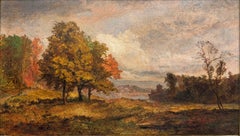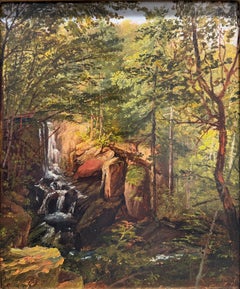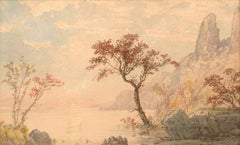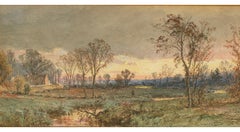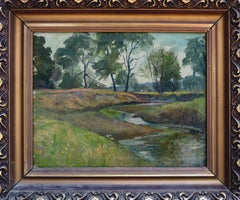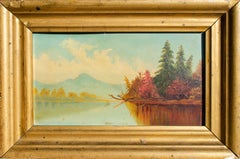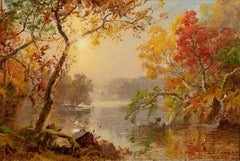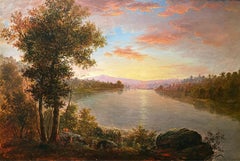Jasper Francis Cropsey Art
American, 1823-1900
Born on Staten Island, New York, Jasper Cropsey became a nationally known luminist landscape painter whose work reflects his interest in architecture and allegorical progression, seasons, etc. Called "America's painter of autumn", he was especially known for his sunlit-ridden fall landscapes.
Reportedly the peak of his career was the creation of a "nine-foot-long canvas of a New York autumn. Its brilliant colors stunned many of the English viewers to whom it was presented in London." (Zellman 202) His painting, Autumn on the Hudson River, was so well received in England that Queen Victoria granted him an audience.
Cropsey had early success, being acclaimed by the press when he was in his twenties. He was trained in architecture, having been apprenticed to an architect when he was age 15, but he turned to landscape painting, which was then gaining acceptance. He was an admirer of landscape painter Thomas Cole and used Cole's Roman studio when studying in Italy from 1847-49. Although Cole was deceased by then, Cropsey adopted Cole's colorful palette and romantic treatment of subject matter.
He lived most of his life at Hastings-on-Hudson, overlooking the Hudson River and traveled and painted extensively in the river valley. However, from 1856 to 1863, he lived in England where the influence of Frederic E. Church replaced Cole.
Source: Michael David Zellman, 300 Years of American Artto
1
2
1
Overall Width
to
Overall Height
to
4
3
1
2
1
1
1
1
1
1
1
4
3
3
3
1
4
9,989
2,754
1,378
1,375
3
4
Artist: Jasper Francis Cropsey
"An Autumn Landscape" Jasper F. Cropsey, Hudson River School, Fall Landscape
By Jasper Francis Cropsey
Located in New York, NY
Jasper F. Cropsey
An Autumn Landscape
Signed and dated J.F. Cropsey 1898
Oil on canvas
14 x 24 inches
Provenance
Private Collection Texas, acquired in the early 1900s
Thence by desc...
Category
1890s Hudson River School Jasper Francis Cropsey Art
Materials
Canvas, Oil
"Janetta Falls, New Jersey" Jasper F. Cropsey, Hudson River Wooded Landscape
By Jasper Francis Cropsey
Located in New York, NY
Jasper F. Cropsey
Janetta Falls, New Jersey, circa 1846
Signed J.F. Cropsey
Oil on canvas
12½ x 10¾ inches
Provenance
Private Collection, New York, 1930s
Thence by descent to the pr...
Category
1840s Hudson River School Jasper Francis Cropsey Art
Materials
Canvas, Oil
Under the Palisades, 1899
By Jasper Francis Cropsey
Located in New York, NY
Jasper Francis Cropsey paints a view out from the Palisades onto the Hudson River in his artwork entitled, “Under the Palisades.”
Category
19th Century Hudson River School Jasper Francis Cropsey Art
Materials
Canvas, Oil
Twilight on the Sawmill River
By Jasper Francis Cropsey
Located in New York, NY
Signed and dated lower right: J.F. Cropsey 1887
Category
19th Century Hudson River School Jasper Francis Cropsey Art
Materials
Paper, Watercolor
Related Items
1920s Century Country Creek Landscape
Located in Soquel, CA
Serene early 20th century landscape of a winding creek in verdant country side with a distant farmhouse in the background, by an unknown artist (American, 20th Century), c. 1920. Pre...
Category
1920s Hudson River School Jasper Francis Cropsey Art
Materials
Canvas, Oil
19th Century White Mountain Landscape, Unknown American School
Located in New York, NY
Unknown White Mountain Artist
White Mountain Landscape, 19th Century
Oil on board
5 x 9 1/4 in.
Framed: 7 3/4 x 11 3/4 in.
Category
19th Century Hudson River School Jasper Francis Cropsey Art
Materials
Oil, Board
Sunset Along the Front Range, Colorado, 1900s Traditional Landscape Painting
By Charles Partridge Adams
Located in Denver, CO
This stunning, original signed landscape watercolor on paper painting by Charles Partridge Adams (1858-1942) captures the breathtaking beauty of a Colorado sunset along the Front Ran...
Category
Early 20th Century Hudson River School Jasper Francis Cropsey Art
Materials
Watercolor
$4,500
H 14.5 in W 17.5 in D 0.75 in
1903 Walpi Hopi Village, Arizona First Mesa Landscape circle of Elmer Wachtel
By Marion Kavanaugh Wachtel
Located in Soquel, CA
Walpi Hopi Village, Arizona First Mesa Landscape by Marion Kavanaugh Wachtel. Significant southwestern painting of Hopi at Walpi Mesa in Arizona...
Category
Early 1900s Hudson River School Jasper Francis Cropsey Art
Materials
Gold Leaf
$20,000 Sale Price
20% Off
H 30 in W 34 in D 2 in
"Grand Manan" Harrison Bird Brown, Maine Landscape, Hudson River School Seascape
By Harrison Bird Brown
Located in New York, NY
Harrison Bird Brown (1831 - 1915)
Grand Manan
Oil on canvas
12 x 20 inches
Signed with initials lower left
Harrison Bird Brown was born in 1831 in Portland, Maine, and is best known for his White Mountain landscapes and marine paintings of Maine's Casco Bay...
Category
Late 19th Century Hudson River School Jasper Francis Cropsey Art
Materials
Canvas, Oil
Late 19th Century Tonalist Landscape -- Afternoon by the Pond
Located in Soquel, CA
Gorgeous tonalist oil painting woman walking in field by pond with home in background by Willis Seaver Adams (American, 1844-1921), circa 1880. Trees and an amazing sky in the background add depth and interest to this beautiful piece. Signed "W. S. Adams" lower right corner. Condition: Previous restoration includes relining of canvas. Frame is vintage gilt molded and wood frame and shows previous repair of molding losses. Image size: 20"H x 24"W.
Auctions records for the artist exceed $6,000.
Willis Seaver Adams was known for his landscapes of the Connecticut River Valley. A relative recluse for much of his artistic life, his loneliness can be seen in much of his works. Oil miniatures were the focus for almost all of his later works. He is credited with over 425 oils, watercolors, and drawings.
Willis Seaver was born in 1844 on a farm in Suffield, near the Connecticut River. He intermittently attended the Suffield Academy, and always wanted to be a painter. A wealthy doctor became his patron, and financed his studies in 1868 at the Royal Academy in Antwerp. When the doctor passed away, Adams returned home and struggled to make a living painting. After working for a photographer for three years, he opened his own studio.
Adams helped organize Cleveland's first watercolor exhibit in 1876. Soon thereafter, he completed a portrait of Rutherford B. Hayes, then governor of Ohio, prior to his becoming President of the United States. This portrait enhanced Adams notoriety.
In 1878, Adams traveled to Italy where he opened a studio in Venice, and became friendly with neighbor James Whistler. Prior to returning to Springfield, Adams lived in Florence, Italy for three years. He returned to became an instructor for the Springfield Art Association, and began to exhibit his works at the galleries of James D. Gill. His first one-man exhibit was held there in 1894. Other successful exhibitions took place in Chicago, New York, and Boston. Although his works garnered respectable prices and reflected his success, Adams felt he was due more recognition.
In 1906, he moved to Greenfield, Massachusetts and converted a barn into a studio. There, he fell into relative obscurity, accompanied mainly by his dog, Collie. In 1921, Adams passed away.
Examples of Willis Adams works can be seen at the Kent Memorial Library, the Wadsworth Atheneum, and the Suffield Academy. Several Suffield residents are thought to own Adams paintings.
Category
1880s Hudson River School Jasper Francis Cropsey Art
Materials
Linen, Oil
$3,160 Sale Price
36% Off
H 25.75 in W 29.5 in D 3.75 in
Hudson River School 19th Century American Landscape Mountains Haystack Horses
Located in Buffalo, NY
This finely executed 19th century oil painting exemplifies the pastoral grandeur and romantic vision associated with the Hudson River School. While the painting is unsigned, it was c...
Category
Late 19th Century Hudson River School Jasper Francis Cropsey Art
Materials
Canvas, Oil
High Peaks in the Adriondacks
By Charles H. Chapin
Located in Saratoga Springs, NY
Charles Henry Chapin - American (1830 - 1889)
“High Peaks of the Adirondacks”
Note: Peaks include Mount Marcy, Haystack Mountain, Basin Mountain, as viewed from the Ausable Lake Area...
Category
Late 19th Century Hudson River School Jasper Francis Cropsey Art
Materials
Canvas, Oil
19th Century Hudson River School Landscape after Richard Goodwin
Located in Soquel, CA
Charming Hudson River school antique oil painting of a sailboat on a lake, circa 1880-90. Signed "R. Labarr." after Richard LaBarre Goodwin...
Category
1880s Hudson River School Jasper Francis Cropsey Art
Materials
Canvas, Oil
$1,218 Sale Price
35% Off
H 10 in W 16 in D 1 in
Antique American Impressionist Hudson River School Coastal Seascape Oil Painting
Located in Buffalo, NY
Antique impressionist painting of a coastal seascape. Oil on canvas, circa 1900. Signed illegibly. Framed. Image size, 18L x 12H.
Category
1890s Hudson River School Jasper Francis Cropsey Art
Materials
Canvas, Oil
$746 Sale Price
25% Off
H 15 in W 21 in D 2 in
Moonrise in the Mountains (Hudson River School Style Nighttime Landscape)
By Jane Bloodgood-Abrams
Located in Hudson, NY
Luminist, Hudson River School inspired landscape of Catskill mountains with moonlit blue sky
"Moonrise in the Mountains", painted by Hudson Valley artist, Jane Bloodgood-Abrams in 20...
Category
2010s Hudson River School Jasper Francis Cropsey Art
Materials
Canvas, Oil
Jane Bloodgood-AbramsMoonrise in the Mountains (Hudson River School Style Nighttime Landscape), 2024
$7,600
H 32 in W 42 in D 2 in
"Mt. Rosalie, Colorado" Albert Bierstadt, Western American Mountain Landscape
By Albert Bierstadt, 1830-1902
Located in New York, NY
Albert Bierstadt
Mt. Rosalie, Colorado, circa 1863
Signed lower left: ABierstadt; inscribed on verso: Mt. Rosalie / Colorado
Oil on paper
13 1/4 x 9 1/2 inches
Provenance
Private Co...
Category
1860s Hudson River School Jasper Francis Cropsey Art
Materials
Paper, Oil
Previously Available Items
Lake Wawayanda, 1881
By Jasper Francis Cropsey
Located in New York, NY
In “Lake Wawayanda, 1881” Jaspar Francis Cropsey depicts trees in autumn color on the shore of a placid lake while the sun begins to set overhead.
Category
Early 1800s Jasper Francis Cropsey Art
Materials
Canvas, Oil, Board
Autumn Sunset
By Jasper Francis Cropsey
Located in Missouri, MO
Jasper Francis Cropsey (1823-1900)
"Autumn Sunset" ca. 1868
Oil on Canvas
23-1/4 x 34 inches / 35 x 44 1/2 inches framed
**Included in the Newington Cropsey Foundation Catalogue Raisonne #2284 - See Images Attached
Provenance
(probably) Barbour
(probably) [unidentified auction, lot no. 631]
Wolfgang Kallen, by 1964
Private collection, Woodbury, New York, by 1964-
By descent in the family to private collection, Fresh Meadows, New York
Spanierman Gallery, New York
to Private Midwest Collection, 2011
Note:
This painting is included in the catalogue raisonne of the work of Jasper Cropsey by the Newington-Cropsey Foundation, Hastings-on-Hudson, New York.
In his 1880 book, Art in America, S. G. W. Benjamin wrote: “The extraordinary variety of the effects of American landscape is…shown by the gorgeousness of our autumnal foliage,” and stated that to paint “effects of sunset, or the scarlet and gold of an American forest in the dreamy days of Indian Summer” was no less absurd than to undertake “to paint the splendor of many-colored drapery in an Oriental crowd,” then “considered a legitimate subject for the artist who has a correct eye for color.” Jasper Cropsey was chief among the artists whom Benjamin saw as capable of seizing “these autumnal displays with fine feeling and excellent judgment,” and he extolled Cropsey’s paintings as “remarkable for their truth and artistic beauty.” Dedicated to the notion that the distinctiveness of the American landscape shone forth best when the wilderness was clothed in the brilliant colors of autumn, Cropsey painted fall scenery...
Category
1860s Hudson River School Jasper Francis Cropsey Art
Materials
Canvas, Oil
“Sunset over Lake Thrasemine”
By Jasper Francis Cropsey
Located in Southampton, NY
Jasper Francis Cropsey, oil on canvas, 1881, Jasper Francis Cropsey (American, 1823-1900), Study for "Sunset Over Lake Thrasemine", signed and dated lower right "J.F. Cropsey 1881",...
Category
1880s Hudson River School Jasper Francis Cropsey Art
Materials
Canvas, Oil
Ruins with Figures
By Jasper Francis Cropsey
Located in New York, NY
Famed Hudson River School painter and architect.
Category
19th Century Hudson River School Jasper Francis Cropsey Art
Materials
Canvas, Paper, Oil
Jasper Francis Cropsey art for sale on 1stDibs.
Find a wide variety of authentic Jasper Francis Cropsey art available for sale on 1stDibs. You can also browse by medium to find art by Jasper Francis Cropsey in paint, oil paint, canvas and more. Not every interior allows for large Jasper Francis Cropsey art, so small editions measuring 11 inches across are available. Customers who are interested in this artist might also find the work of John Frederick Kensett, William Bradford, and William Trost Richards. Jasper Francis Cropsey art prices can differ depending upon medium, time period and other attributes. On 1stDibs, the price for these items starts at $57,500 and tops out at $325,000, while the average work can sell for $130,000.
